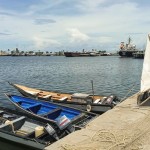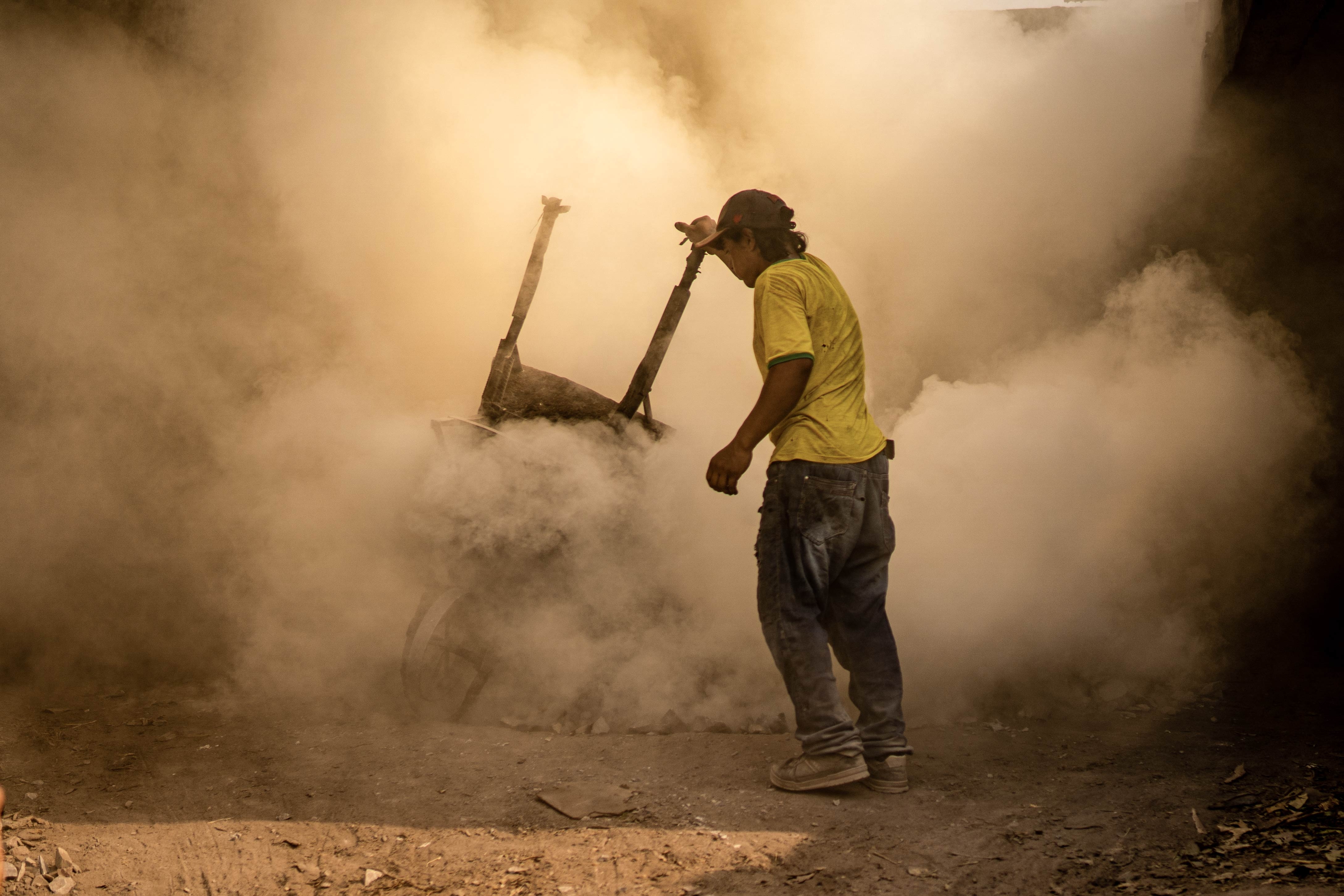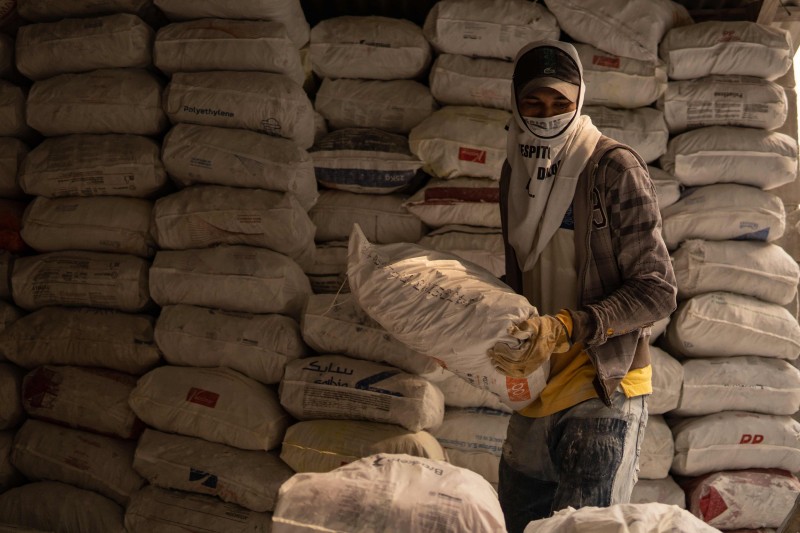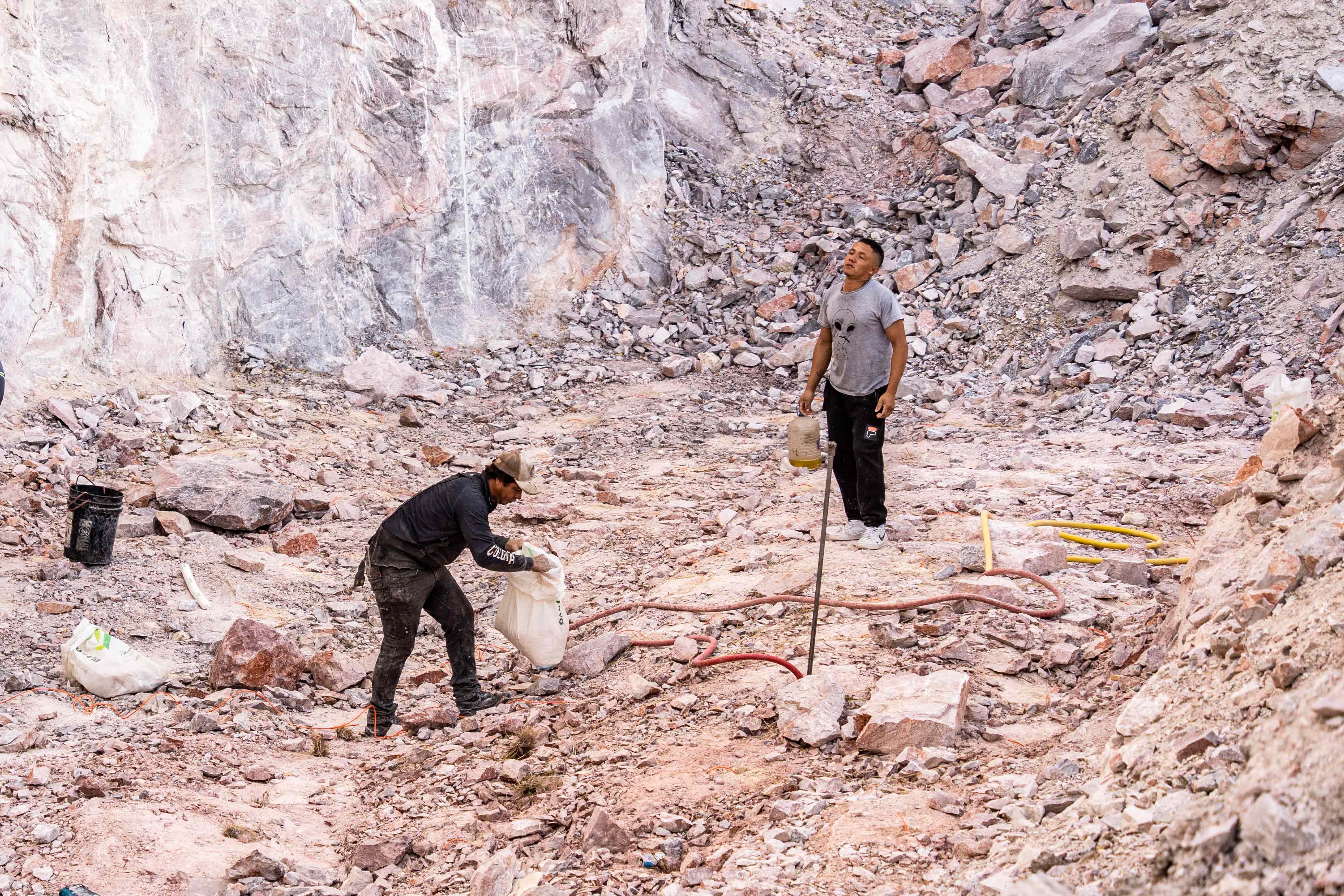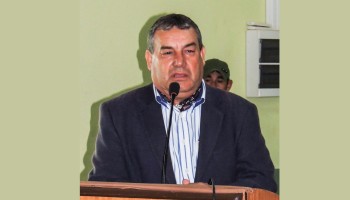Sitting atop the trunk of a pink lapacho tree, an 11-year-old boy takes his hammer to an enormous piece of limestone. He hits, and hits, and hits at it, until finally he succeeds: The stone splits open into fragments that can be thrown into a nearby kiln to form quicklime, a key ingredient in cement.
The boy works alongside other children every morning until noon in a state-owned limestone quarry in Vallemi, a town in northern Paraguay’s district of San Lázaro near the Brazilian border.
Their parents and grandparents also toil in the quarry, but for a full ten-hour day, six days a week. Instead of face masks, which cost too much, they wrap their mouths and noses with rags or old clothes to avoid inhaling the dust of the limestone kiln, which burns at 1,000 degrees and emits a constant, thick smoke that coats the entire area in white powder.
Teenage cement workers cover their mouths and noses with rags to protect themselves from limestone dust.
These are typical working conditions in the Vallemi quarries owned by the National Cement Industry (INC), one of Paraguay’s largest state companies and cement producers.
The limestone cliffs that surround the town have afforded its inhabitants a livelihood for generations. Most locals have worked in the cement industry their entire lives: mining the hills, breaking down the limestone, or operating kilns that turn it into quicklime.
Though the quarries came under the control of the INC several decades ago, the miners are technically freelancers and their working conditions are not monitored by INC — or seemingly anyone at all. Children like the 11-year-old are a frequent presence in the quarries, even though it is illegal in Paraguay for children under 14 to work on dangerous sites. Many families say they would not be able to get back without help from their children.
"It’s easy for people to criticize,” says Edson Ramirez, a kiln owner in Vallemi. “But all too often, if these children don't work, they can't eat or buy a notebook.”
The Vallemi valley.
Paraguay’s booming economy is undergirded by huge growth in the construction and agribusiness industries — two sectors thirsty for limestone and dolomite, which comes from some of the same quarries and can be processed into cement, or spread across the ground as fertilizer for cash crops like soybeans.
But the workers of Vallemi haven’t reaped the profits of this boom. In fact, they say their livelihoods have deteriorated since 2014, when they reached an agreement with INC to pay the company a fee for every ton of stone they mine.
“It’s a labor sector without any support,” said María del Pilar Callizo, a Paraguayan labor lawyer who has followed the issue.
The quarries were once owned by a private Argentinian firm, Vallemi SA, which eventually went bankrupt in 1969 and transferred its assets to the country's Central Bank.
But the local families who had been working for the foreign company couldn’t leave. After the company withdrew, they continued on as artisanal miners. Although the state-owned INC was created in 1970 by the government of military dictator Alfredo Stroessner, it did not interfere with the local miners in Vallemi until the mid-2000s.
Cement miners working on the slope of Cerro Tigre in Paraguay.
The issue came to a head in 2012, when authorities tried to stop locals from working in hills they said belonged to INC. Two years later, they reached an agreement; the INC "formalized" the role of the artisanal miners and permitted them to continue extracting limestone in exchange for a set fee of around $1 per ton of stone mined.
Now, these miners exist in a legal gray zone, Callizo explained: Although INC owns the quarries, it subcontracts a local quarrymaster who is technically responsible for the working conditions there. Under this arrangement, INC has no legal obligations to those who toil in its mines.
“Neither the quarrymaster nor the miners have medical insurance or social security,” said Callizo. “They don’t have any legal protection or social support.”
Nine limestone miners interviewed by a journalist from El Surti and OCCRP said they barely earned enough to cover the costs of mining the cliffs. Many said they were in debt. Meanwhile, accidents are common and respiratory diseases are widespread due to the thick white dust of the kilns, according to the town’s only doctor, Rodriguez Urbieta. (Scientific studies have found that exposure to a cement plant is associated with respiratory disease and raises the risk of cancer.)
Cement miners in Paraguay are frequently exposed to limestone dust, leading to respiratory diseases.
“The lime kilns [are] harmful, but people have to make a living,” he said.
Despite the health risks, San Lazaro municipality does not have any pulmonology specialists, or even a hospital. When something serious happens, patients have to be transferred 160 kilometers away.
“In this area, the absence of the state is notable,” said Digno Cañete, who leads the Federation of Miners of San Lázaro, an umbrella group of workers’ cooperatives that represents a total of 500 artisanal miners.
Manuel Zarate, a legal adviser to INC, said the state company wasn’t legally obligated to monitor the working conditions in the hills around Vallemi, but that it tried to “do what it can to help the workers.”
“Unfortunately, they expect more than we can give," he said.
Behind the Boom
Edson Ramirez’s lime kiln is seven meters high, with an opening at the top through which the stones are fed. When a piece of lime has fully cooked, it falls to the base of the kiln. Experienced cement workers like Ramirez can recognize a rock’s purity by the sound it makes when it strikes bottom.
The 49-year-old, who is stocky and speaks with a husky voice, has spent his life in the mines, exposed to the thick dust of the kiln his father and grandfather built in the 1970s.
"This is the only thing I know how to do, or want to do,” he said.
His 12-man team uses rakes and iron wheelbarrows to separate out the best pieces for sale and packs them into sacks, working in shifts to withstand the sweltering heat inside the kiln.
A cement miner carrying sacks of limestone.
The fruits of their labor may end up in a public infrastructure project or a new luxury building, as a real estate boom transforms the skyline of Paraguay’s capital, Asuncion.
The country currently has the highest economic growth of any country in Latin America and the Caribbean, according to the World Bank, thanks in large part to the construction and agribusiness industries. But behind Paraguay’s macroeconomic success lies a darker picture. Concentrated land ownership, high levels of corruption and a regressive tax system keep a quarter of the population in poverty and working conditions that in some places verge on slave labor.
Nowhere is the contrast between the wealth generated by these industries and the poverty of those who provide the raw materials more apparent than in Vallemi.
Although Ramirez is an experienced kiln operator, he is so far down the supply chain that he says he can barely make ends meet. One of his 30-kilogram sacks of lime sells for 13,500 Paraguayan guarani (about $2), meaning he needs to sell at least 200 sacks to pay his team enough to cover the cost of a day’s worth of simple food for their families: rice, cassava, and beans.
According to INC’s adviser Zarate, the $1 per ton fees the state company collects from the miners amounts to around $130,000 per month, a sum he described as negligible.
But for the self-managed workers like Ramirez, it’s just one more expense that makes it harder to make ends meet.
“Right now, [miners] aren’t the owners of the land on which they work; they have no tools; they have nothing,” said Cañete, the head of the Miners Federation. Despite having come together to form a cooperative, the miners are still unable to secure large loans to develop their businesses with better equipment, he said.
The cement miners of Vallemi are often poorly equipped.
Cañete dreams of harnessing better technologies to speed up the work, from trucks to collection systems and stone crushers, as well as state university courses that would allow the miners to improve their skills and compete with larger companies.
Callizo, the labor lawyer, believes the mine workers of Vallemi should be granted special protections under the law given the “uniquely” dangerous conditions in which they work, which include exposure to extreme heat and long hours.
“There are some gaps in our labor law regarding them. They need special regulation, a specific approach, because I understand that neither the supervisors nor the miners have medical insurance, social security.”
As the local artisanal miners struggle, INC says it is also barely making ends meet, reporting annual deficits and a major drop off in production in recent years. The firm produced just 373 million kilograms of cement in 2023, down from 649 million kilograms in 2018.
That was also the year that the head of INC, Jorge Mendez Cuevas, stepped down from his post. He soon became the head of a new private firm, Cementos Concepcion (CECON), that is now positioning itself as the largest national cement producer — and INC’s biggest competitor.
Cementos Concepcion, known as CECON, installed a huge plant in San Lázaro, and now accounts for roughly 45% of the country’s cement production, using materials mined from its own quarries.
Mendez was one of a number of public officials in the administration of President Horacio Cartes — later sanctioned by the U.S for corruption — who have come under fire for benefitting from a so-called “revolving door” between government and private industry after Cartes left power in 2018.
INC adviser Zarate acknowledged that CECON and other large companies are better equipped than the state-owned cement company. "The big ones [large companies] even have better machinery than ours. They have a different level of exploitation and you see them working with a different approach."
But he said the miners interviewed by El Surti and OCCRP were exaggerating their troubles.
“They’re not lying, but there are some half-truths in their complaints,” he said.
“This is Where I am Going to Die”
Juan Pablo Torres is hoping for a “good explosion.” The quarrymaster and his team place gelatin dynamites, which they call “bananas,” into holes in the rocky hillsides around Vallemí and light the fuse.
The explosion booms out across the landscape. A cloud of sand, stone, earth and dust surges upwards like a burst water pipe, and the ground shakes for hundreds of meters.
An explosion in a quarry in Vallemi.
Torres is happy: With 25 years of experience, he can immediately see that the explosion was a good one. A stone embankment has been transformed into a small mountain of rocks. He and his team set about sorting the pieces; dolomite will be sold to large factories to make agricultural lime, while limestone will head to artisanal kilns like the ones operated by Edson Ramírez, for use in cement.
Though Torres studied in Asuncion, the 43-year-old says he returned to San Lazaro because the quarries are part of his life — even if the money is meager. He said the artisanal miners needed more government support. Although as a quarrymaster he technically has responsibility for the workers in his quarry, he said he is also living hand-to-mouth. “The way we are working, more and more businessmen come and we are being left out,” he said.
But even without improvements, most people in Vallemi have no choice but to stay here and keep working the hills. Cañete, of the miners’ association, said that cement mining was simply a way of life.
“This is what we are. Our people live off this,” says Cañate. “This is my life and this is where I am going to die.”
A version of this story was also published in Spanish by El Surti in Paraguay.

